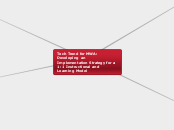Tech Trend for MWA: Developing an Implementation Strategy for a 1:1 Instructional and Learning Model
Step 3: Planning
Develop a list of proposed applications and uses of technology. This list would consist of but not be limited to types of activities, physical environments or locations, when and with what frequency. One example of a proposed application and use would be SBAC testing.
Generate a list of hardware, software, infrastructure and other technical requirements based on the list of proposed applications and uses.
Select hardware, software and other supporting technologies.
Develop a support plan that accounts for supporting additional hardware, software and supporting technologies.
Ensure security and information privacy controls are planned for. Ensure CIPA compliance.
Ensure that Instructional Technology Support Staff develop a strategy and concrete plans for implementation of this new model.
Create a professional development and training plan based on the new modes of learning and the learning and instruction model being implemented. This PD plan will include initial and ongoing training and collaboration on the technology tools that will be used to support the new model. Ensure all users of this new model, where paper is replaced with digital interaction and communication, are included, i.e. administrators, staff, faculty, students, parents and others as needed. Leadership must be able to serve as role models for adopting new technologies.
See excerpt from article in November Learning titled Why Schools Must Move Beyond One to One Learning:
"Leaders must be given the training to:
Craft a clear vision of connecting all students to the world’s learning resources.
Model the actions and behaviors they wish to see in their schools.
Support the design of an ongoing and embedded staff development program that focuses on pedagogy as much as technology.
Move in to the role of systems analyst to ensure that digital literacy is aligned with standards.
Ensure that technology is seen not as another initiative, but as integral to curriculum."
Develop a budget for initial implementation and a define a budget policy that secures ongoing funding.
Ensure an ongoing process is established for re-assessing the 1:1 learning and instruction model and it's supporting technologies.
Establish metrics and an evaluation model to determine effectiveness of new model so that successes and areas of improvement are identified.
Step 4: Implementation
Create project plan(s) for implementation. Ensure realistic and achievable goals and timelines are established.
Purchase hardware, software, supporting technologies and perform infrastructure upgrades ahead of deployment and training.
Ensure support personnel and other support requirements are in place.
Ensure security compliance processes, procedures and infrastructure are in place.
Ensure hardware, software, supporting technologies and infrastructure upgrades are deployed ahead of go live and PD.
Perform professional development with all necessary groups: administrators (leadership), faculty, staff, students and parents.
Step 1: Build a case for a 1:1 Initiative
Survey a short list of other public charter schools that have developed and implemented a successful 1:1 learning and instructional model that has produced tangible positive results (data). Use results of the survey to identify other school models that could be reproduced at our school.
Identify studies and reports, such as those found at the Speak Up reports section on the tomorrow.org website, that demonstrate how one to one learning and instructional models can positively affect learning and instructional outcomes.
Survey students, teachers and staff about how a 1:1 learning and instructional model could positively affect learning and teaching outcomes. Use the survey to identify clear objectives and strategies for using technology to enhance and improve learning and teaching.
Use NETS Assessment results to identify deficient areas. Develop proposed strategies in a 1:1 learning and instructional model that would address these deficiencies.
Step 2: Create a Shared Vision
Identify stakeholders that will collaborate as a team to develop a shared vision of the school's new 1:1 learing and learning model. Stakeholders may include parents, students, staff, faculty, administrators, and board members.
Present findings from step 2 to various stakeholder groups and gather specific feedback to be included in the vision statement/proposal.
Identify core sub team to develop a statement/proposal draft. Identify stakeholder groups that will approve and ratify draft.
Seek approval and ratification of vision. Seek approval for next steps and timeline for planning and implementation.
